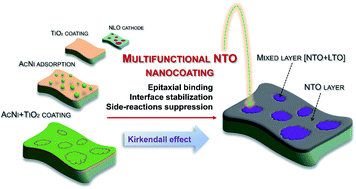Multifunctional NiTiO3 nanocoating fabrication based on the dual-Kirkendall effect enabling a stable cathode/electrolyte interface for nickel-rich layered oxides†
Abstract
Surface modification is an essential step in engineering high performance nickel-rich layered (NLO) cathode materials that can withstand the increasingly harsh environment encountered in lithium-ion batteries. However, most traditional technologies suffer disadvantages such as low diffusion kinetics, processing difficulties and/or compatibility issues. Here, based on the dual-Kirkendall effect, we report an efficient, self-guided way for fabricating a multifunctional NiTiO3 (NTO) nanocoating to stabilize the cathode/electrolyte interface for NLO. The NTO nanocoating can epitaxially and chemically bond to the surface framework of NLO particles and eliminate surface lithium residues by evolving into a Li–Ni–Ti–O mixed phase coating that is mainly composed of Li2−xTiO3. Taking full advantage of such a novel multifunctional NTO nanocoating, the structural degradation in NLO cathodes can be effectively suppressed, leading to excellent rate capability and cyclability. This method provides insights into novel surface chemistry that prevents high performance layered electrode materials from structural degradation.



 Please wait while we load your content...
Please wait while we load your content...